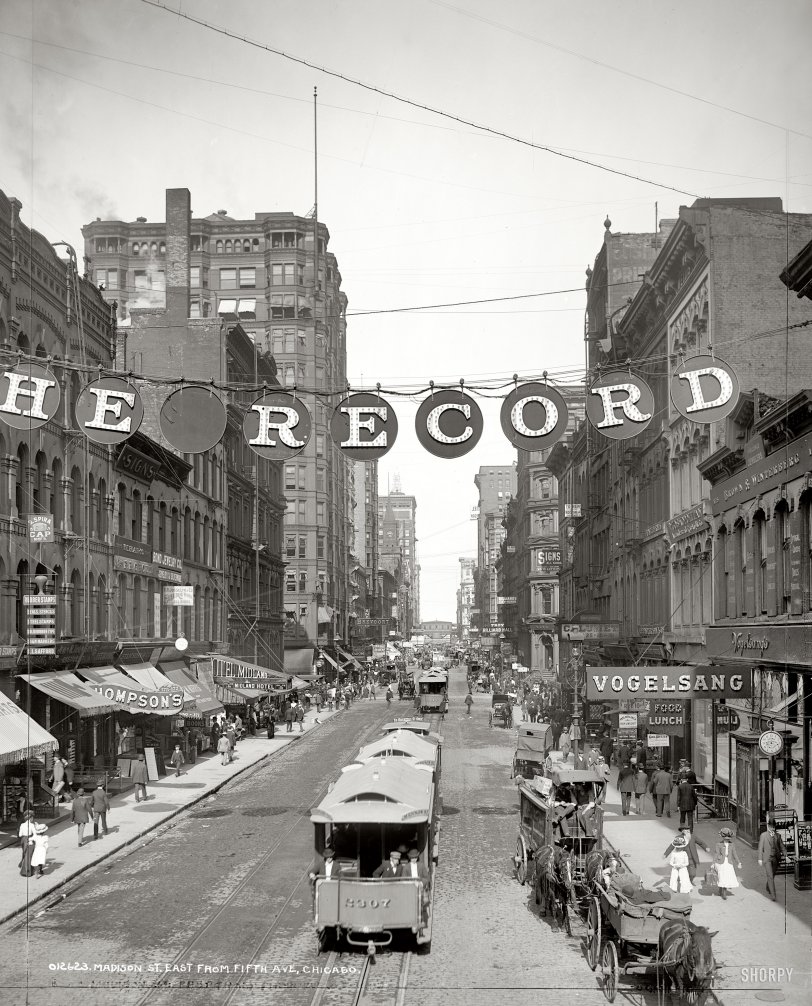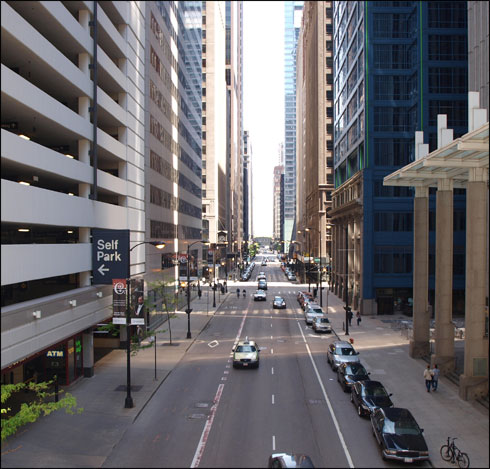


Framed or unframed, desk size to sofa size, printed by us in Arizona and Alabama since 2007. Explore now.
Shorpy is funded by you. Patreon contributors get an ad-free experience.
Learn more.

- Lofty addition
- In 1912
- Keenan Building
- Six years old
- Taken from the P.J. McArdle Roadway?
- It stood only 47 years
- Three track mind
- Incline to the right
- Reach for the sky, 1912 style
- No clean sweep
- Same Job Title, Same Face
- Sadly Lost
- Beautiful ...
- Where you get your kicks
- Aim High
- Pueblo Revival sisters
- Pueblo Neoclassicism
- Milk Man
- Regional dialect.
- Spielberg's inspiration
- Great Photo
- Loaf Story
- Do you still have the Rakes category?
- Could almost be a scene from the 1957 movie 'Hell Drivers'
- The Wages of Fear.
- Conspicuous by their absence
- Got Milk?
- All that aluminum
- No lefties
- Smoke 'em if you've got 'em
Print Emporium
That Toddlin Town: 1900

September 1, 1900. Chicago, Illinois. "Madison Street east from Fifth Avenue." 8x10 inch dry plate glass negative, Detroit Publishing Company. View full size.
Billiard History of Chicago
This particular strip of Madison was a mecca for billiard businesses (and players) at the time. You'll notice the Breevort Hotel sign on the left. It was owned and operated by Hannah & Hogg, one of Chicago's most successful and well known liquor distributors, who also operated the city's most luxurious bars and billiard halls.
Other billiard hall signs can been seen as well, including (distant on the right) a sign for Mussey's. This establishment (since the late 1800s) was well known across America as one of the nations leading billiard and bowling venues.
Although you cant discern it in this photo, on Dec 15, 1892 at the intersection of Madison and State, Emanuel Brunswick (a stepbrother of Brunswick's founder - John M. Brunswick) was struck and killed by a street car as it rounded the corner. (same kind of car shown in photo)
Officially known as a "grip cars," these streetcars vary slightly from cable cars. A grip car utilizes a moving cable under the street, whereas a cable car is usually driven by an electric line overhead.
[The "cable" in cable car refers to the traction cable under the street. - Dave]
Lon Chaney and the free lunch
This must have been the same thing that Lon Chaney Jr. (Creighton Chaney) spoke of in a documentary about his father. When Lon Sr. was a struggling stage actor, he would go to places that offered a free lunch. He would buy a beer, which entitled him to go to the free lunch table. He would make a sandwich, then wait until he didn't think anyone was looking, and put the sandwich into his pocket. Then, he'd make another, and keep doing that until he had enough to feed his wife and son, too, all for the price of one beer!
May 2010
Here's the view today from the same vantage, looking East from the L at Wells & Madison.

West Chicago Street Railroad
The Madison Street cable car line was operated by the West Chicago Street Railroad, which was owned by Charles Tyson Yerkes, a famous robber baron. The line was converted to electric on August 19, 1906.
Wells and Fifth
That intersection is only two blocks away from my office, where I'm sitting right now. Suffice it to say that virtually none of the buildings pictured (except some of those far in the background, at the east end of Madison) are still standing. Wells is both the original and current name of that cross street. It was originally named for Billy Wells, a hero of the War of 1812, but the street eventually became so notorious as a vice district that its name was thought to be an insult to Wells' good name, so in 1870 the name was changed to Fifth Avenue. Once the vice district was finally cleaned up, the name was changed back to Wells.
Horse & Electric
Interesting to note that one track is electrified while the other is for horsecars.
No thanks
One has only to read "The Jungle" to know what you were eating at the "free" lunch counter. Ewwwwwwww!
A Free Lunch
From the mid 19th century until Prohibition, it was common for bars and taverns to have a "free lunch" table. It often consisted of sandwiches, roast turkey being common. (Turkey was the cheapest meat of the time, much like chicken is now.)
Almost always, there was a one-drink minimum purchase required for access to the table, and the indigent or down-on-his-luck fellow might be found trying to eat and run without a purchase. Sometimes, the food selection ran towards salty in nature, so as to provoke thirst in the customers, but in other locations saloons would compete with each other based on the quality of their free lunch table. And, of course, this was the source of the saying "there ain't no such thing as a free lunch".
Wabash El
Center background is the El station at Wabash and Madison - Nancy says it's still there!
Burned
This area, along with all of what is now called the Loop, was completely destroyed by the Chicago Fire of 1871. But it was quickly rebuilt, mostly by 1873; many of the buildings in the foreground appear to date from that initial period of reconstruction.
Signage City
What was "The Record"? That sign almost looks modern in its execution; like something out of the 50s or 60s. And it isn't a simple sign. Any ideas, anyone?
[The Chicago Record was a newspaper published from 1893 to 1901. - Dave]
Billiards & beds
Where would you stay: The Hotel Midland with rooms for 50¢, 75¢ and $1, or, the Calumet with rooms for 25¢, 20¢ and 15¢ plus the option of weekly rates of $1, $1.25 and $1.50? Think it over while spending 30¢ per hour in the pool hall. If you're a down on your luck pool shark, perhaps you could win enough for the (assumed) better rooms at the Hotel Midland. If you're losing at pool, save enough for a stay in the Calumet.
Question about the Fire.
I'm curious to know if this area was destroyed by the Chicago fire.
Signs, signs, everywhere there's signs
There are at least three signs for sign makers in this photo, and from the looks of things they must have all been working overtime.
What time is it?
The hands of the clock in the building tower in the distance (Middle left) show the SAME TIME as the jewelry store clock in the lower right, even though the hands on the jewelry store clock are obviously PAINTED ON! Weird coincidence!
[It's 3:40 by the tower clock. At the jeweler's it's always 8:17. - Dave]
Wells to Fifth
My first thought was there is no Fifth Avenue in Chicago. But I found that Wells Street was renamed Fifth in 1870 and back to Wells in 1916.
No such thing
Right next door to Vogelsang's restaurant (which presumably does NOT give it away), there is a sign advertising "Free Hot Lunch."
I wonder what you had to do to qualify. Listen to a sermon? Make a long-distance telephone call?
It must have been something. Because, you know the saying ...
Tacoma Building
The tall building on the left is the Tacoma Building of Holabird and Roche, built 1887-1889 and demolished in 1929. It was the first skyscraper designed by the firm, and it used to be described as the first skyscraper - period. (That honor is now disputed among several other buildings in Chicago and New York.) The Tacoma was also the first large building built by a general contractor, the George A. Fuller Company, which later built the Flatiron Building in New York as its corporate headquarters.
Who Says?
There's no such thing as a free lunch? It's not only free, it's HOT. You can even get an night lunch, according to the sign.
The view today
The photo must have been shot from atop the El. Here's the current view from Fifth (now Wells Street) looking east along Madison:
MY GOSH!!! the detail is amazing...
These are without a doubt my FAVORITE type of Shorpy pics. The clarity and detail found in these 100 year old photos blows me away. Its so easy to imagine walking this street. I'd love to see what it looked like in color (but I must say, I prefer the B&W). I wonder what it smelled like?
Cable Cars
Back in the late 1800s, Chicago had a cable car system. My great-grandfather was an engine house engineer for it.
























On Shorpy:
Today’s Top 5